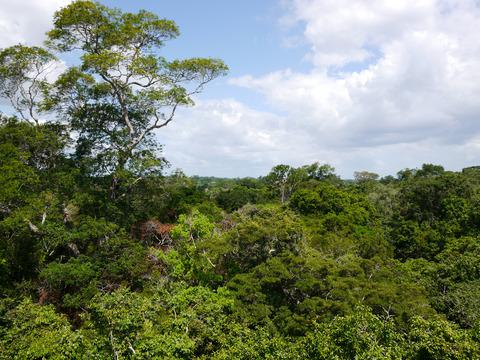当前位置:
X-MOL 学术
›
Funct. Ecol.
›
论文详情
Our official English website, www.x-mol.net, welcomes your
feedback! (Note: you will need to create a separate account there.)
The response of carbon assimilation and storage to long‐term drought in tropical trees is dependent on light availability
Functional Ecology ( IF 4.6 ) Pub Date : 2020-09-29 , DOI: 10.1111/1365-2435.13689 L. Rowland 1 , A.C.L. da Costa 2, 3 , R.S. Oliveira 4 , P.R.L. Bittencourt 1, 4 , A.L. Giles 4, 5 , I. Coughlin 6, 7 , P. de Britto Costa 4, 5 , D Bartholomew 1 , T.F. Domingues 6 , R.C. Miatto 6 , L.V. Ferreira 3 , S.S. Vasconcelos 8 , J.A.S. Junior 2 , A.A.R. Oliveira 7 , M. Mencuccini 9, 10 , P. Meir 6, 11
中文翻译:

碳同化和储存对热带树木长期干旱的响应取决于光的可用性
更新日期:2020-09-29
Functional Ecology ( IF 4.6 ) Pub Date : 2020-09-29 , DOI: 10.1111/1365-2435.13689 L. Rowland 1 , A.C.L. da Costa 2, 3 , R.S. Oliveira 4 , P.R.L. Bittencourt 1, 4 , A.L. Giles 4, 5 , I. Coughlin 6, 7 , P. de Britto Costa 4, 5 , D Bartholomew 1 , T.F. Domingues 6 , R.C. Miatto 6 , L.V. Ferreira 3 , S.S. Vasconcelos 8 , J.A.S. Junior 2 , A.A.R. Oliveira 7 , M. Mencuccini 9, 10 , P. Meir 6, 11
Affiliation

|
- Whether tropical trees acclimate to long‐term drought stress remains unclear. This uncertainty is amplified if drought stress is accompanied by changes in other drivers such as the increases in canopy light exposure that might be induced by tree mortality or other disturbances.
- Photosynthetic capacity, leaf respiration, non‐structural carbohydrate (NSC) storage and stomatal conductance were measured on 162 trees at the world's longest running (15 years) tropical forest drought experiment. We test whether surviving trees have altered strategies for carbon storage and carbon use in the drier and elevated light conditions present following drought‐related tree mortality.
- Relative to control trees, the surviving trees experiencing the drought treatment showed functional responses including: (a) moderately reduced photosynthetic capacity; (b) increased total leaf NSC; and (c) a switch from starch to soluble sugars as the main store of branch NSC. This contrasts with earlier findings at this experiment of no change in photosynthetic capacity or NSC storage. The changes detected here only occurred in the subset of drought‐stressed trees with canopies exposed to high radiation and were absent in trees with less‐exposed canopies and also in the community average. In contrast to previous results acquired through less intensive species sampling from this experiment, we also observe no species‐average drought‐induced change in leaf respiration.
- Our results suggest that long‐term responses to drought stress are strongly influenced by a tree's full‐canopy light environment and therefore that disturbance‐induced changes in stand density and dynamics are likely to substantially impact tropical forest responses to climate change. We also demonstrate that, while challenging, intensive sampling is essential in tropical forests to avoid sampling biases caused by limited taxonomic coverage.
中文翻译:

碳同化和储存对热带树木长期干旱的响应取决于光的可用性
- 热带树木是否能适应长期干旱压力仍不清楚。如果干旱胁迫伴随其他驱动因素的变化(例如树木死亡或其他干扰可能导致的树冠光照增加),则这种不确定性会加剧。
- 在世界上运行时间最长(15年)的热带森林干旱试验中,对162棵树进行了光合能力,叶片呼吸,非结构性碳水化合物(NSC)存储和气孔导度的测量。我们测试了幸存的树木是否改变了干旱造成树木死亡后在干燥和高光照条件下碳储存和碳使用的策略。
- 相对于对照树,经历干旱处理的存活树显示出功能性响应,包括:(a)光合能力适度降低;(b)叶片总NSC增加;(c)由淀粉转为可溶性糖作为NSC分支机构的主要储备。这与该实验中先前的发现相反,即光合作用能力或NSC储存没有变化。此处检测到的变化仅发生在顶盖暴露于高辐射下的干旱胁迫树木的子集中,而在顶盖暴露较少的树木和社区平均值中则没有。与通过该实验通过较少强度的物种采样获得的先前结果相比,我们还没有观察到干旱引起的物种平均干旱变化。
- 我们的结果表明,对干旱胁迫的长期响应受到树木全树冠光环境的强烈影响,因此,由干扰引起的林分密度和动态变化可能会极大地影响热带森林对气候变化的响应。我们还证明,尽管具有挑战性,但在热带森林中进行密集采样至关重要,以避免因有限的生物分类覆盖率而引起的采样偏差。











































 京公网安备 11010802027423号
京公网安备 11010802027423号